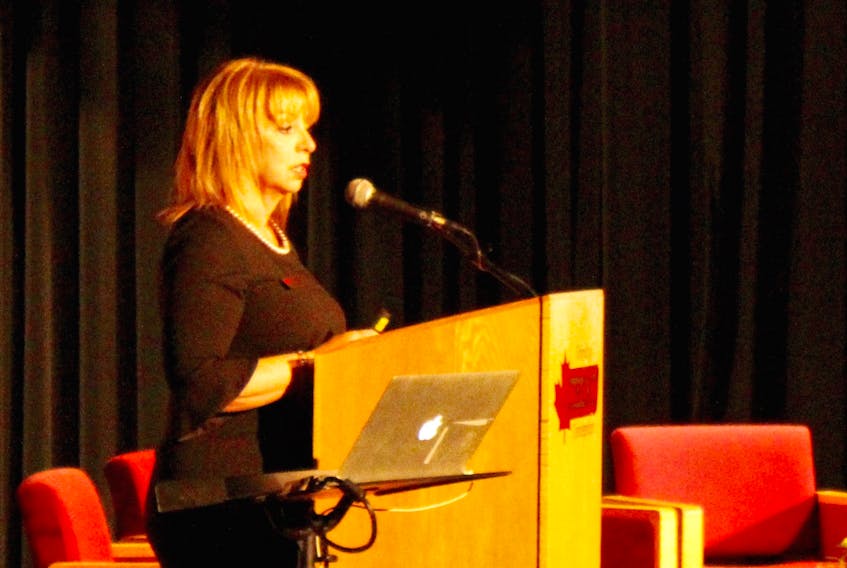CARBONEAR, NL — Several businesspeople from the Conception Bay North area got together to fill up the Princess Sheila NaGeira Theatre Tuesday afternoon, April 17, for a panel discussion regarding the goings-on of local businesses, as well as the future of the local economy.
Hosted by the Harris Centre and the Community Business Development Corporation (CBDC) for the Trinity Conception region, the event involved business owners from all sorts of industries such as restaurants and the food industry, as well as the fishery industry. Some up-and-coming business minds were also in attendance, with the intention of learning more of the possibilities that Carbonear and surrounding areas offered them economically.
The main focus was the problems or challenges the local economy faced, and how business owners could work together to overcome them.
Before getting deep into any major details, Diane Hodge-Burt of CBDC took to the stage to overlook some demographics for the region, the majority of which pointed out the region’s aging population.
We're live in carbonear talking about the future of the economy in Trinity Conception. https://t.co/gjBYVI931j pic.twitter.com/O9SK39XXyZ
— Harris Centre (@harriscentre) April 17, 2018
Statistics she presented indicated between 2011 and 2016, the region’s population saw an approximately 23 per cent increase in residents aged 65 years and older, whereas the number of residents aged 15-64 went down by five per cent. Likewise, overall population for the region saw a 1.9 per cent decrease, with almost every community seeing some sort of decrease in young residents, while the number of residents aged 65 and up saw a steady increase. This overall decrease, while significant, is well below the provincial average of 4.2 per cent.
“We’ve been hearing about the rapidly aging population and out-migration of young people in the province for years,” Hodge-Burt said. “The situation in our region isn’t really vastly different from that reality. That being said, we’re not the hardest hit region for it, and on the grand scale, we’re not doing too badly. In order to sustain the current population, and slightly grow the region, we’ll require at least 4,000 individuals between the ages of one and 24-years.”
Hodge-Burt went on to explain that youth retention is certainly an issue in some parts of the region, stating that immigration will play a large role in the repopulation of younger demographics.
“We’re currently exploring ways in which we can partner with (the Association of New Canadians) to ensure our business community is welcoming of everyone,” she said.
Later in the event, the topic of immigration’s impact on the economy of the region was brought up during a panel discussion between Hodge-Burt, Jamie Ward and Alvin Simms of the Regional Analytics Lab at the Harris Centre, Merv Wiseman – a pioneer in the fur farming industry, and Robin Quinlan, vice president of Quinlan Brothers.
Getting ready for the panel discussion on the economy in Trinity Conception. Watch live https://t.co/gjBYVI931j pic.twitter.com/lMl85r1h9b
— Harris Centre (@harriscentre) April 17, 2018
Justin Campbell of the Association of New Canadians spoke up from the audience to ask the panel what the business community was doing to help attract newcomers to the area, what more they could be doing, and what resources they may need to help retain people.
Wiseman spoke up, noting the job vacancy rate in the agriculture industry across Canada is 7.2 per cent, with the average age of farmers in the province being around 50-60-years.
“If we don’t have the ability to incorporate new Canadians into the workforce equation, let’s face it, the agriculture industry will be dead in the water,” he said. “We will not achieve our goals and objectives, so we have to be smart about that. That’s something we have to work on as a community.”
Wiseman added a need to move Canadians outside of urban areas in order to create communities with jobs and entrepreneurship opportunities to attract new citizens. With some solutions in mind, he hopes to see the necessary changes come into action over the coming years.
“We’ve got some solutions, and now it’s just a question of trying to activate them. We’ll see, maybe in the next year or so, how we’re going to approach that.”
Regionalization was also a big talking point for the panel. A question from a member of the audience brought about the discussion of how to better bring municipalities of the region together, noting the often-begrudging attitude of communities taking part in events being hosted by neighbouring towns.
“One of my most frustrating things when trying to get regional development going in this province is the lack of cooperation between municipalities,” said Simms. “I can tell you right now, if there is no cooperation at a municipal level, you’re going to fail as a region. Secondly, if they fail to cooperate, in twenty years, no one will be any better off. You’ll still be where you are today.”
Simms went on to explain that development in one community does not necessarily mean it’s only beneficial for that community alone. He said this is something communities in the region need to get a better grasp on in order for regionalization to be successful.
“Carbonear can still benefit from major developments in Bay Roberts, and vice versa. Communities need to work together more if you want to see any sort of regional development at all. Without that cooperation, nothing is going to change.”









